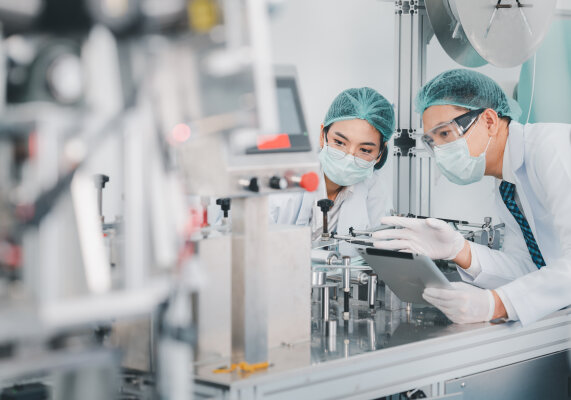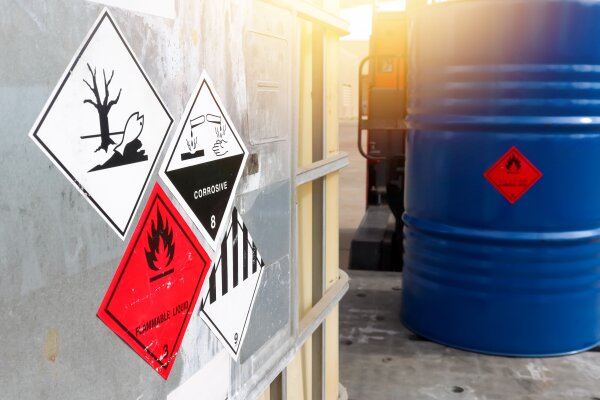Separation of mixtures by centrifugation: all about the topic

In chemistry, centrifugation is a process in whichmixtures of substances are separated from one another by the application of centrifugal forces. This can be useful for various applications, such as the differential or analytical method. Find out here how a centrifuge works, what it is used for and what to look out for when handling the device.
What is a centrifuge?
A centrifuge is a technical device for separating mixtures of substances by means of centrifugal force. The centrifugation definition is therefore that mixtures of substances with two or more phases are separated by the application of centrifugal forces, which in turn is directly dependent on the centrifugal force, the mass, the angular velocity and the distanceof the body from the axis of rotation.
Centrifuging can be compared to spinning wet laundry in a washing machine or to the principle of a salad spinner – the high speed creates centrifugal forces so that the solid particles are pressed to the bottom of the test tube or container. The liquid parts split off and can be decanted.
The design of the centrifuge corresponds to this principle: it is equipped with a centrifuge chamber for separating the material and with a motor for generating the revolutions. It usually holds several tubes, which can be arranged in a circle inside the device.
What is the purpose of centrifugation?
Centrifugation is a commonly seen procedure in chemistry and is most common in engineering, laboratory, human medicine and space medicine. Phase separation can be used, for example, to separate blood components or to split solid and liquid particles in the suspension. The principle can also be found in everyday life – think, for example, of skimming milk, spinning laundry in the machine, or removing honey from the comb.
In addition,several centrifugation techniques can be distinguished for sample preparation in the laboratory. These are roughly divided into differential centrifugation, analytical ultracentrifugation and isopycnic or zone centrifugation.
Differential centrifugation
Differential centrifugation takes advantage of differences in sedimentation rates to obtain different cell fractionsand separate them further and further. For this purpose, the samples are placed in the centrifuge one after the other, with the rotational speed and velocity being increased more and more. The supernatant is removed after each step and then re-centrifuged.
It is often common to start at a speed of 1,000 g (g as a multiple of the mean acceleration due to gravity) and then centrifuge the supernatant at 2,000 g again. Microsomes and small vesicles are separated last at 80,000 to 150,000g.
Analytische Ultrazentrifugation
Analytical subcentrifugations are particularly suitable for special problems, as they require a powerful centrifuge and an optical detector– for example, a refractometer or a spectrophotometer. UV-transparent cuvettes are used, which are provided with sapphire or quartz omissions.
The absorbance of the sample is measured repeatedly during centrifugation. The concentration of the sedimented particles can then be determined from these measured values, which can be used, for example, to calculate the sedimentation coefficient of the individual molecules.
Isopycnic and zone centrifugation
On the other hand, if the particles have similar sedimentation velocities but different sizes, isopycnic centrifugation (which is also known as zone centrifugation) may be considered. The sample is placed on a discontinuous density gradient consisting of several layers of ascending concentration and centrifuged at low speed. The particles then form on the gradient.
Process in chemistry: Centrifugation
However, centrifugation is not the only process in chemistry for separating substances. Instead, a number of other options come into question. However, these do not all relate to the separation of multiphase mixtures of substances, which is why they are sometimes only applicable to other chemical matters.
In direct comparison, the advantage of centrifuging is often that both substances are preserved and can be practically completely separated from each other. This can be practical in the lab. Comparisons can be made, for example, to the following procedures:
-
Filtration: Molecules are separated from each other by a membrane with a small-pored filter (think of filtering brewed tea). However, only incomplete phase separation is possible, since liquid also remains in the filter.
-
Decanting: Solids and liquids are separated from each other due to different densities. A good example is the pouring of sediment into wine. This method is also incomplete, unlike centrifugation.
-
Sieving: Different densities or particle sizes also play a role in sieving, so that mixtures of substances are passed through sieves with suitable hole sizes.
-
Separation: Separation works with a separating funnel so that substances with a greater density remain at the bottom and those with a lower density rise to the top. In this process, however, the liquids cannot be mixed, which again is a difference to centrifugation.
- Evaporation: When a mixture of substances is evaporated or evaporated, the volatile solvent is lost through a drying process. Only the solid is isolated and separated.
How to centrifuge correctly: Do’s & Don’ts
In order to obtain a meaningful laboratory result during centrifugation, attention should be paid to some important precautions. In addition to the centrifuge application notes, there are other do’s and don’ts when it comes to the optimal operation, loading and use of this process.
Common mistakes
At the top of the list is the avoidance of common mistakes – so working with the centrifuge quickly becomes routine. Common errors can include something like the following:
-
Incorrect loading: It is important that all tubes and beakers can oscillate symmetrically and uniformly during centrifugation. If equal weight classes are not used at opposite positions, appropriate balancing is missing. The same applies if the load is too high – then the speed may be reduced, which can also have a negative effect.
-
Unsuitable tubes: In addition, make sure that only suitable bottles and tubes are used in the centrifuge. These must have chemical and mechanical resistance, must not tilt the lid when closing the device and must be undamaged.
-
Lack of cleaning: If the inside of the centrifuge is not thoroughly cleaned at regular intervals, corrosion can occur due to the effects of chemicals and moisture. Therefore, the rotor should be cleaned and dried after each run.
-
Loose rotor: Speaking of the rotor – if this elementary component is mounted too loosely or is not seated correctly, damage is also inevitable. This should definitely be checked before each operation of the centrifuge.
-
Excessive rotor service life: The service life of a rotor is also limited, which results from the high g-forces when using the centrifuge. The rotor must be regularly checked for scratches and damage and replaced after some time.
- Release of microorganisms: Anyone working with aerosols and other microorganisms must also pay attention to tight containers and careful handling. If aerosols are released in the device, they cause contamination and can sometimes be hazardous to the user’s health.
Centrifuge correctly
How to centrifuge properly in chemistry comes from reversing the most common mistakes – as long as the above precautions are followed and steps are taken, the user is mostly on the safe side. In addition, care should be taken to ensure that the centrifuge has a safe distance of about 30 cm from all surrounding objects and can easily move in case of doubt during rotation and vibration. In addition, there are the following maxims for clean working with the centrifuge:
-
Setting the speed: The speed per minute indicates the speed at which the centrifuge rotates. This should always be adapted to the material in the unit, whereby orientation to DIN 58970-2 is possible. Many modern laboratory instruments automatically convert the rotational speed into the RZB (Relative Centrifugal Acceleration), which is now authoritative.
-
Observance of any waiting times: Some laboratory samples also require multiple centrifugations, with waiting times between each run. The same applies to the duration of centrifugation – there are specifications for this as well.
- Checking the centrifugation conditions: In addition, make sure that the samples are centrifuged at the correct temperature and that the container matches the specifications of the material. This also includes storage temperatures, lighting and any expiration dates.
Centrifugation should be performed with care
Centrifugation is one of the common processes in chemistry and is used to separate mixtures of substances, relying on centrifugal force. Since centrifuges develop a high speed, care should be taken during operation to ensure correct performance and handling of the instrument, tubes and containers, and laboratory samples. If you avoid common mistakes and make sure your work is clean, you’ll be on the safe side.
Do you have questions about the topic or would you like to suggest a topic? Bitte kontaktieren Sie uns telefonisch unter +49 30 2096579 00 oder senden Sie uns eine E-Mail an info@medsolut.com.




